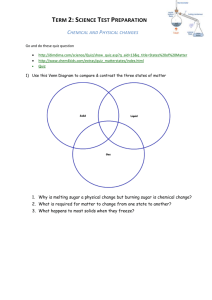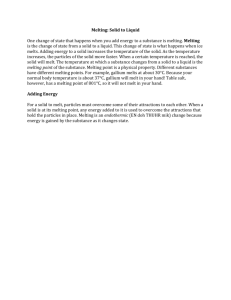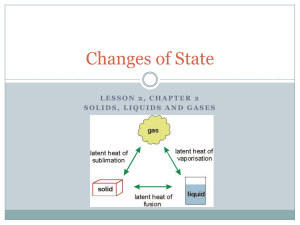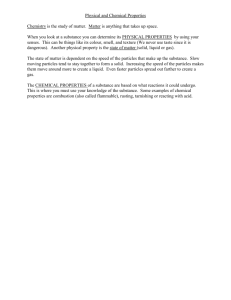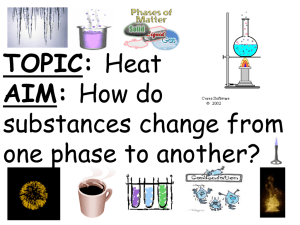Knowledge Test 2 Materials and Their Properties
advertisement
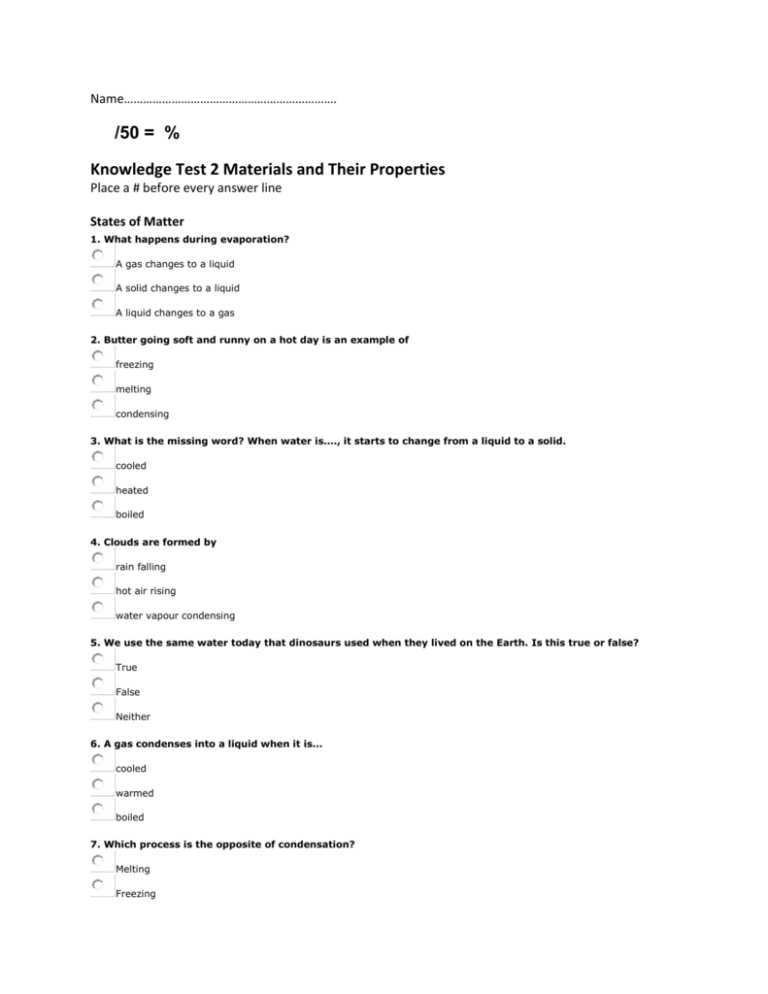
Name…………………………………………………………. /50 = % Knowledge Test 2 Materials and Their Properties Place a # before every answer line States of Matter 1. What happens during evaporation? A gas changes to a liquid A solid changes to a liquid A liquid changes to a gas 2. Butter going soft and runny on a hot day is an example of freezing melting condensing 3. What is the missing word? When water is...., it starts to change from a liquid to a solid. cooled heated boiled 4. Clouds are formed by rain falling hot air rising water vapour condensing 5. We use the same water today that dinosaurs used when they lived on the Earth. Is this true or false? True False Neither 6. A gas condenses into a liquid when it is... cooled warmed boiled 7. Which process is the opposite of condensation? Melting Freezing Evaporation 8. Which of these statements is FALSE? Evaporation is a change that can be reversed Evaporation only happens at 100°C Evaporation is helped by heat and by wind 9. The movement of water around and around our world is called... condensation the water cycle evaporation 10. Which of these is NOT a part of the water cycle? The Sun evaporates water on the Earth's surface into water vapour The water vapour rises, and cools and condenses into clouds When it rains, the clouds melt Characteristics of materials 1. Why couldn't you use a plastic towel? It would be too bendy It wouldn't be absorbent It wouldn't conduct heat 2. Why wouldn't you sit on a glass chair? It might shatter It wouldn't be absorbent It would be transparent 3. Where do metals come from? From rocks called ores From fibres woven together From trees 4. How is glass made? By heating sand By mashing up wood from trees By weaving fibres together 5. How is paper made? By heating sand By mashing up wood from trees By weaving fibres together 6. Metal is used for nails because it ... rusts is shiny does not bend easily 7. Wood is used for matches because it ... floats rots burns 8. Rubber is used for wellington boots because it ... floats is opaque is waterproof 9. Which spoon is it safer to stir very hot soup with? A metal spoon A wooden spoon A paper spoon 10. Material A is stretchy but not absorbent. Material B is very absorbent but does not stretch. Which makes the best swimwear? Material A Material B Both Material A and Material B make good swimwear Gases, liquids and solids 1. Which of the following is NOT a gas? Air Car exhaust fumes The sea 2. You blow up a balloon. Is it heavier or lighter than the uninflated balloon? Heavier Lighter They weigh the same 3. When you squeeze a sponge under water, what are the bubbles that escape? Pieces of sponge Air coming from the spaces in the sponge Water 4. Which material is a liquid? Sponge Shampoo Salt 5. Which material is a solid? Syrup Cooking oil Cotton wool 6. To change a solid metal to a liquid, you would heat it cool it bend it 7. Which of these is NOT an example of a solid? Dust Runny honey Gravel 8. Which one of these best describes a solid? My particles are packed tightly together. I keep my shape. My particles are loosely packed. I take the shape of my container. My particles have lots of room. I try to spread out in every direction. 9. Which one of these best describes a liquid? My particles are packed tightly together. I keep my shape. My particles are loosely packed. I take the shape of my container. My particles have lots of room. I try to spread out in every direction. 10. Which one of these best describes a gas? My particles are packed tightly together. I keep my shape. My particles are loosely packed. I take the shape of my container. My particles have lots of room. I try to spread out in every direction. Different changes 1. Which substance can dissolve completely in water? Sand Flour Salt 2. Substances that dissolve in water are called solutions insoluble soluble 3. How could you separate a mixture of sand and salt? Mix with water, filter, and then evaporate Mix with water, evaporate and then filter Filter and then mix with water 4. Will the steam from seawater be salty? Yes No Some of the steam will be salty 5. Are melting, freezing, boiling, evaporating and condensing ALWAYS reversible changes? No Yes Only sometimes 6. Which of these is a reversible change? Metal rusting Baking a cake Freezing orange juice to make an ice lolly 7. Which of these is an irreversible change? Candle wax melting Candle wax burning Ice cream melting 8. What new materials are formed when a candle burns? Melted wax Water and carbon dioxide and soot No new materials are formed 9. How could you change burnt paper back into its original form? Cool it Scrape off the soot You can't 10. Which of these statements is FALSE? Freezing is not a reversible change Heating a substance can cause both reversible and irreversible changes Dissolving is a reversible change Solids and liquids 1. I can be 'got hold of'. I don't change shape when you move me. What am I? A solid A liquid Neither a solid nor a liquid 2. I cannot be picked up. I take the shape of any container. What am I? A solid A gas Neither a solid nor a gas. 3. Which of the following are examples of liquids? Wood and paper Shampoo and oil Shoes and socks 4. Sugar and sand can be poured. Are they examples of solids or liquids? Solids Liquids Neither 5. When a solid is heated, it turns into a liquid. This is called ... dissolving freezing melting 6. When a liquid is cooled, it turns into a solid. This is called ... dissolving freezing melting 7. Evaporation is when a gas is cooled and changes to a liquid a liquid is heated and changes to a gas a solid is heated and changes to a liquid 8. Once a solid has turned to a liquid, can it be changed back to a solid again? No, it can never be turned back into a solid Yes, by heating it Yes, by cooling it 9. Condensation happens when a gas is cooled a liquid is cooled a solid is cooled 10. How would you stop butter melting on a hot day? Leave it on the table Put it in the oven Put it in the fridge
